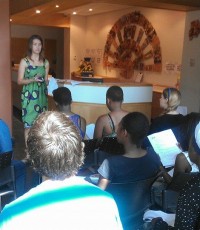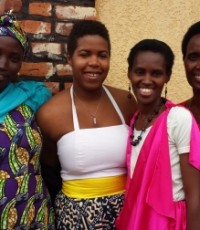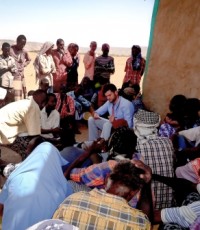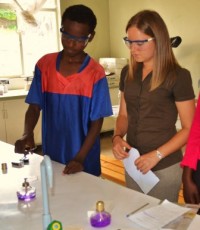July - August 2014
Dear Friends,
As this summer comes to a close, more and more of our 2014-15 Fellows are heading out to their fellowship posts across the African continent. All in all, we have 49 amazing Fellows working in 15 countries with 30 partner organizations.Our Fellows graduated from 35 different colleges and universities with 33 different majors, from International Development to Mechanical Engineering, Business Administration to Sociology. They speak 23 languages (from Swahili to French to Setswana) and come from 11 different countries and 15 states.
This fellowship year, we are thrilled to be partnering with eight new partner organizations: African School of Economics, Comprehensive Community Based Rehabilitation in Tanzania (CCBRT), Global Shea Alliance, Hope Through Health, Indigenous Education Foundation of Tanzania (IEFT), The Kasiisi Project, Population Services International (PSI), and The Rwanda School Project. In addition, Hope Through Health is based in the Kara region of Togo, making Togo the 35th country to date for the PiAf program.
It’s hard to believe, but we are currently gearing up for our next fellowship year! Our 2015-16 fellowship application will go live in late August, and applications will be due by Sunday, November 2, 2014 at 11:59PM EST. Please check out our website for more information or e-mail piafapp@princetoninafrica.org to be added to our applicant mailing list.
We hope you enjoy this edition of the Fellows Flyer!
Warm regards,
Katie Henneman
Executive Director
PiAf Connections
Please click below to check out pictures of our Fellows, Alums and other members of the PiAf family meeting up at home and around Africa.
Notes from the Field
By Elise Barry, 2013-14 Fellow with International Rescue Committee in Ethiopia
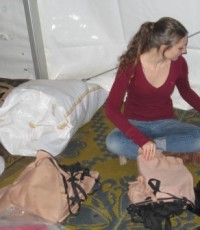
Elise packing dignity kits for the thousands of female returnees deported from Saudi Arabia in an IRC relief effort.
From my upbringing as a stubbornly independent young one and the teachings of some incredible African Studies professors, I have always cringed away from the neocolonialist flavor of development organizations ‘saving’ people and the idea of rescue as a whole. So, it was with some trepidation that I left 12 months ago to join the International Rescue Committee in Addis Ababa. While I still firmly believe that I haven’t rescued anyone and that no one here needs to be rescued, this experience and the organization have taught me that sometimes we all need to be reminded of the tools we can use to rescue ourselves. So, here is my tried and true Addis rescue toolkit:
Find your calm
Addis is a city sedately steeped in history and tradition, which is now desperately trying to incorporate all the benefits and detriments of development. With new buildings going up on every street and roads constantly changing their routes on you, it is both an exciting and frenetic swirl of color and culture and construction from which you sometimes need to step back and find your happy place. For me, this has come in the form of my trusty yoga mat. Not only is it guaranteed to get you some very curious spectators, but potentially a few new friends and yoga enthusiasts to boot. While lunchtime yoga in the IRC conference room still gets some raised eyebrows and tentative grins from my colleagues, I’m convinced I’ll win over a few more of them soon.
Perspective
There will always be a delicate balance in development between the overenthusiastic save-the-world mentality and the cynic who writes off development altogether – somewhere between idealistic trust in the field of development and the tendency to become jaded by the world of demanding donors and insufficient funds. Sitting in front of a computer in Addis, it can feel very far and detached from the people the IRC is aiding, and I have had moments of frustration at my inability to do something more tangible than write reports, proposals, and success stories. In January though, I was able to gain a bit more perspective as a crisis came to my backdoor and I helped with the IRC’s relief efforts for the thousands of Ethiopian returnees deported from Saudi Arabia. I was given a similar perspective check with the opportunity to visit three refugee camps in the north of Ethiopia and to see firsthand the powerful difference the IRC makes in people’s lives, and that I have been able to be a part of in my own small way.
Community
Stepping off the plane last August into a city drenched in rainy season where I knew a grand total of zero people, Ethiopia at first seemed a somewhat chilly place. However, the country and the incredible community I found here soon won me over. Outside of work, I have been exploring the beauty of Ethiopia, laughing with friends who manage to get me up on stage at the open mic Bev Mbu and I started here, and enjoying the rich and varied interactions you can find in a city that houses the AU, a fierce nationalism, and the intersection of interesting characters that result from this combination.
Laughter
From confusing the Amharic word for “thank you” (amesegenallew) with the word for “I love you” (afeklehalu) on my second day, to the smiles that greet me as I emerge panting from my seven-flight climb to the office (it takes more than a year to acclimate to altitude in my opinion), to adventures with friends, a little laughter goes a long way and is a universal language.
So, while I personally think the IRC should still consider changing its name to better convey the incredible work it does and respect the incredible people with whom it works, armed with a yoga mat over my shoulder, great friends around me, a good dose of perspective, and laughter trailing behind, this year has helped me better appreciate the idea of rescue.
Notes from the Field
By Douglas Bove, 2013-14 Fellow with Village Enterprise in Kenya/Uganda
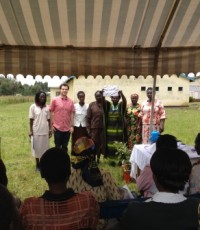
Doug (second from the left) with a graduating business group (three business owners comprise a business group).
There’s already a palpable buzz in the air as our 4Runner pulls up to the tent in Moi’s Bridge, a small town outside the city of Eldoret. This community center-cum-clinic has been converted for the day into a venue that will host the celebration of a group of Village Enterprise (VE) business owners who have reached the end of our program. It’s Graduation Day for this business savings group (BSG)—one comprised primarily of women—which embarked on this journey over a year ago.
Village Enterprise requires a great deal of self-motivation and commitment from its beneficiaries and attrition from the program is the inevitable reality in which VE operates. VE expects their business owners to adhere to a strict regimen of rigorous attendance, detailed business planning, group cohesion, and determined saving for upwards of 12 months, and it is a virtual certainty that 100% of the individuals who begin the program will not reach its conclusion.
As I settled in for this first-ever graduation ceremony, I couldn’t help but think back to my own past graduations. The feeling of having applied myself to something for so many years to now finally see it bear fruit was empowering and filled me with excitement and anticipation for what other amazing things I could and would accomplish someday. I saw that same sentiment painted on the faces of these jubilant graduates. For most of them, this was the only graduation ceremony they’d ever been a part of—the first time anyone had ever recognized their achievements.
I made a brief speech praising the dedication of the graduating BSG; expounding on how they have demonstrated their potential; and urging them not to rest on their laurels but rather to double down and keep striving. And as I stood there in front of everyone, I began to take notice of the other people in attendance. It struck me at that moment that as great as I had felt when it was my turn to walk across the dais and realize the gains of my hard work, it paled in comparison to how some of the people in that audience felt. My mother and father, my younger brother and sister, my classmates in lower grades—they all were getting as much out of watching this ceremony as I was from participating in it.
In the audience that day were representatives of the local government who were able to see tangible evidence of improved livelihoods in their district and there were new business owners at the beginning of the program who were able to glimpse what the end of the journey looked like at a time when they may have been full of doubt. There were positive externalities all over.
But will graduation make an actual difference in VE success rates? In truth, the effect of these graduation ceremonies is difficult to measure directly, as its beneficiaries are leaving the VE program and its monitoring apparatus. Are graduates more likely to succeed in their next endeavor than those who did not participate? It may not ever be feasible for an organization the size of VE to answer such questions, but as the ceremony came to close and the time came to cut into the cakes, the knock-on benefits were on full display. Singing, dancing, eating, laughing, tree planting, and general revelry abounded as a crowd of nearly 100 celebrated the achievements of their neighbors, family members, business partners, and community members. Whether graduation day will become the newest feature of VE’s core program has yet to be decided—the pilot is still being tested and its outcomes captured. Nonetheless, on that day I would have been hard-pressed to deny the intrinsic value of them.
Notes from the Field
By Danielle Boyda, 2013-14 Fellow with Baylor International Pediatric AIDS Initiative in Botswana
If you had told me, a year ago, that I would have spent eight months of my PiAf fellowship by now preparing a major research study about “sugar daddies,” I might have been surprised. If you had told me that that process would include one month of writing grant proposals, six months of adjusting and re-adjusting the study design, four months of writing research approval applications, three months of making budgets and implementation plans, two months of harassing Ministry officials for meetings, and a surprisingly short period of time to decide that this was a project worth staying in Southern Africa for, perhaps indefinitely, I would have been thrilled.
As my fellowship experience at the Baylor Children’s Clinic in Botswana has evolved from primarily running peer support groups for HIV-positive teenagers to also designing a study to test the effectiveness of a short curriculum to help students both HIV-positive and -negative avoid the risk of exposure, a common theme has been the unique challenges that adolescents face. Teens care more about the authority of other teens than the authority of adults. They are still developing their logic and reasoning skills and have highly skewed risk perceptions, strongly prioritizing short-term, tangible gains over longer-term potential risks.
Over the last couple of months, these challenges have moved far out of the abstract in the wake of unexpected patient deaths—one a beloved community leader who stopped taking his ARV medications out of fear that his new friends would shun him if his status was exposed. I was surprised by how frustrated and powerless I felt in the face of his death. Working with Teen Club gives me a chance to provide the teens with a support group with which they can be fully open and supportive of each other’s status—capitalizing on the peer-centered nature of adolescence.
The same risk trade-offs come into play when girls decide to have relationships with much older, wealthier men—the short-term economic gains outweigh the potential risks of HIV. But the problem is two-fold, because youth don’t even know the risks of HIV among older partners. My project to teach students that in Botswana these older partners are a shocking nine times more likely to be HIV-positive than youth is an attempt to bring long-term risks to life. Over the next year, we’ll test whether we can effectively tip the scales in adolescent decision-making about a risky situation.
I am more energized by this opportunity to proactively save lives than I would have expected. Each step of the process, from making the seventeenth (or is it fifty-seventh?) plan revision to pondering the Theory of Change, has been challenging but extremely fulfilling.
Notes from the Field
By Arien Cox, 2013-14 Fellow with Indego Africa in Rwanda
Engaging in a meaningful way with the very colorful women of Indego Africa’s partner cooperative Cocoki was easily the most rewarding experience I had during my fellowship. My relationship with the women began my first day of work, when I was introduced to them as their new English teacher. I was instantly bombarded with a number of questions that ranged from my heritage to my relationship status. From then on, my relationship with them grew.
Despite their limited mastery of English and my not-at-all mastery of Kinyarwanda, we bonded. My trips to see the women always filled me with joy, and my heart routinely melted from affection upon seeing the love in their eyes when they saw me come through the doorway every Wednesday morning. Most importantly, I felt a sense of accomplishment as their English improved as a result of my tutelage.
Towards the end of my fellowship, I received a stunning rhinestone and flower encrusted ivory invitation from one of my students, Fabiola. She was getting married and invited the whole office to her wedding just on the outskirts of town. A couple of weeks later on an exquisite Sunday morning, my coworkers and I piled into the car and drove into the countryside. We crammed ourselves into the small church along with at least 100 other people and listened to an identically-dressed choir sing church songs in Kinyarwanda, as well as a fairly progressive sermon on why it is important for men to treat women with respect in marriage.
After the ceremony, everyone gathered outside to take photos. I snapped a couple of pictures with my students, as well as the bride. It was a wonderful moment for me, as I got to experience a beautiful social and cultural event with my new lifelong friends.
Notes from the Field
By David Friedman, 2013-14 Fellow with Save the Children in Ethiopia
Save the Children is one of the largest non-governmental organizations in Ethiopia and works to improve the lives of children through interventions in education, health, nutrition, rights, protection, water, and livelihoods. As a Fellow, I worked under the Business Development team, which was responsible for coordinating, compiling, and reviewing proposals prior to submission.
My experience gave me a glimpse into the world of large-scale development, including its merits, its oddities, and its foils. In the process, I learned about a variety of subjects and subsequently took a keen interest in education and youth programming. At first, my interest developed solely through my work with proposals, of which education projects constituted the largest focus. However, at the halfway point of my fellowship, I moved to eastern Ethiopia to research technical and vocational education and training (TVET) programs in pastoral areas, and it led me to discover topics I had never considered.
My work put me in contact with youth in urban and rural areas, including students, non-students, and graduates, as well as parents, farmers, and herders. TVET was intended to prepare youth for employment, but with a scarcity of formal business opportunities, there were too few jobs for graduates. The transition from school to work was perilous and by the numbers, many would never be able to use their degree. In effect, their skills were useless without opportunities to apply them.
The question became: how do you grow businesses in areas with few resources? It was very different from the project that brought me to eastern Ethiopia, but the two were linked. I turned to my colleagues at Save the Children for answers and we began to map out what we wanted in a program for TVET youth. We listed ideas ranging from life skills training and literacy to entrepreneurship and apprenticing. Some of the activities, we could offer, but how would we provide apprenticeships to electrical engineering graduates or experience in hotel management? My colleagues pointed out that a project such as this would require participation of the private sector. Our task would be to support the growth of businesses by providing and mentoring qualified youth, but much of what was needed would have to come from elsewhere – through strong partnerships.
Other questions arose. Would it be better if our program targeted only one or two industries, enabling us to play a more prominent role in linking youth to select jobs? The notion of “factory towns” is not foreign to the West, but we would inevitably be discouraging personal choice, and I could not begin to imagine how such a model would work within pastoral communities in practice. The deeper into project design we plunged, the more I understood how important engaging the private sector was to our own objectives. Moreover, as I looked beyond the margins of my own work, I saw new ways of tackling common issues from the private sector that I wanted to explore.
Notes from the Field
By Meghan Smith, 2013-14 Fellow with Project Mercy in Ethiopia
I began teaching at Project Mercy in rural Ethiopia last September. On my first day of instruction for grade 8 biology, I taught an overview of the five senses. As I described the eye, I didn’t realize this sense organ would occupy much of my time second semester.
While teaching grade 6 English, I noticed that one of the girls in my class rarely wrote the notes or completed the homework. The boy who sat beside her explained that despite sitting in the front of the class, she couldn’t see the blackboard, the teaching aid used for communicating notes, homework, and tests. This made me wonder how many other students might have similar vision problems.
It was obvious to me that in this poor rural setting, their families could never afford for them to visit an eye doctor. After much planning and consideration, I began screening students in grades 5-12 for vision problems. With the help of a short-term medical team, I was able to screen 345 students in just a few days.
Since then, I have taken 57 students to the eye clinic, 22 of whom have received glasses and nearly all of whom have undergone minor procedures or received medicine for conjunctivitis, eye allergies, or other bacterial infections. Those who did not receive glasses were often diagnosed with permanent eye problems (such as corneal scars, lazy eye, and retinal detachment). This meant their vision could not be corrected by the use of lenses. Many of these problems are caused by trachoma, so education on keeping flies away from their eyes at a young age, washing their faces daily, and keeping their living conditions clean has been an essential part of each student’s visit to the clinic. The eye project will be continued in future years by the medical team that helped me with the initial screenings.
Although this project has occupied much of my time outside of school, I have also spent time hiking in the mountains, traveling around the country and getting to know the children who live in the compound.
My primary work included teaching biology, chemistry, and science lab classes to grade 6-12 students, English to grade 6 students, reading to grades 1-4 students, and English classes twice each week to Ethiopian teachers for whom English is their second or third language. My work in the laboratory included developing a laboratory manual as well as expanding upon existing materials. I also worked throughout the year as a “school nurse,” treating the minor cuts and wounds of the students.
Although I was initially assigned the position of “science laboratory teacher,” I was delighted to be given the opportunity to work and interact with students and teachers in other settings. From that initial teaching of the sense organs came a vision and realization of a breadth of possibilities I had never imagined.



